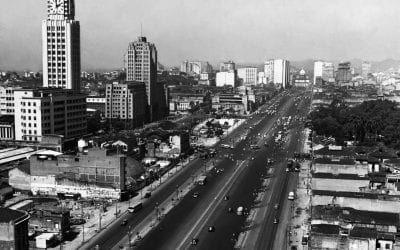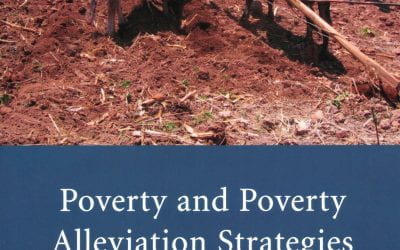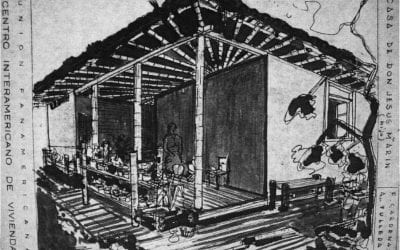Beyond Nature
Parks Shaping Society

Here is the Parque del Este image, circa 1963. Parque del Este was designed by Roberto Burle Marx, the great brazilian landscape architect, and it is his most important work in Caracas. Photo courtesy of John Stoddardt.
The Parque del Este in Caracas, Venezuela, was designed by noted Brazilian landscape architect Roberto Burle Marx (1909-1994). Built between 1956 and 1961, it opened at a critical time in Venezuela’s history, during the onset of what was to be its longest period of democracy. The park was also the keystone piece in the expansion of the city, which had experienced vertiginous growth as Venezuela evolved from an agricultural economy to a wealthy oil producer.
Originally conceptualized as a public ground for the exhibition of tropical flora, Parque del Este is the most intensely used public space in Caracas. The park hosts three distinct spaces. The first is an open, fluid landscape of grassy fields with a subtle and gently undulating topography and loosely laid-out canopy trees, popularly used for picnics and games. The second is a forested, spatially dense landscape with meandering paths, used primarily for strolling and quiet contemplation. The third is a sequence of paved, intimate courtyard gardens that invoke the Spanish colonial past of Venezuelan culture and display plants, tiled murals and water works. Within these spaces visitors are confronted with the rich variety and exuberance of tropical flora, with a small but significant zoological collection of species from different regions of Venezuela. The park is, like most large urban parks, a “green” oasis in the middle of the congested, dirty and noisy city. It is important, however, to point out from the outset that Parque del Este is not a conventionally naturalistic park that could easily be confused with a piece of countryside set inside the heavily built environment. It is, instead, clearly a constructed urban landscape, remarkable for its visual, spatial and material richness.
As a recreational public space within the context of a designed landscape, Parque del Este was a new experience for Caraqueños. Although two parks of significant size had been built in Caracas, El Calvario in 1874 and Los Caobos in 1924, they were located at what were then the outskirts of the city. They faced serious competition with the smaller but omnipresent plazas that constituted the public space of everyday life Caracas. The colonial city was a pedestrian, densely built city, and the plazas’ life hinged on pedestrian traffic throughout the day. When Caraqueños abandoned the colonial city for modern suburbs, they also abandoned a mode of recreation and public life that centered around the plaza. Parque del Este absorbed those functions and offered a new and much broader spectrum of recreational possibilities than the earlier parks, signaling an entire new way of engaging public spaces and nature.
No other parks of the size and programmatic scope of Parque del Este have been built in Caracas. Yet the city has grown beyond all expectations. Around the “city of eternal spring,” as Caracas has been widely known, there are now extra-legal settlements so extensive that some reach upwards of 200,000 inhabitants. Conservative estimates calculate that more than half of the city’s four million inhabitants live in barrios. Venezuela’s urban poor make up 80% of the population. Six out of every ten of these urban poor live in extra-legal settlements around the country’s north shore. Parque del Este is today, most fundamentally, a middle ground between the two opposing realities of the city. What is the basis for this middle ground? First, like parks at their best, Parque del Este is an intensely used public space where people of all social classes meet. The park’s popularity has exceeded all expectations. Planned for 6,000 visitors per week, it received 65,000 visitors per week by 1990. The park has developed into a veritable common ground for all Caraqueños, irrespective of social class. It is used with equal intensity by people from the barrios and by people from the affluent neighborhoods of the city. To the initial program established by Burle Marx—people-watching, strolling, eating and playing—have been added courts for basketball, soccer, volleyball, and ping-pong, and a 1.6 mile-long jogging course. In addition, religious, dance and sports clubs regularly use the park to meet. Burle Marx’s tropical stage sets have become the prime site of contemporary metropolitan life. Particularly compelling is the introduction of the private, domestic realm into the space of the park. Ten kiosks located throughout the park are often used for the celebration of birthday piñatas, first communions and other family events. Parque del Este is a democratic space in the sense that it offers people of all social classes a full spectrum of possibilities for the unfolding of their lives. It works as a public landscape because it enables visitors to appropriate its grounds for a multiplicity of their own uses, thus allowing them to construct their own modes of social practice. If we take the definition of public space as being a place where multiple and not necessarily prescribed or compatible functions coexist, then we can say that Parque del Este is a public space in the fullest sense of the word.
Second, as a work of public art, widely present and available to all, the park is the only access all Caraqueños, and especially barrio dwellers, have to visual culture, to design, to art. We seem to insist, here in the West, on the so-called experience of nature as the prime conceptual justification for parks. The case of Caracas, however, questions the primacy given to this concept. There is plenty of nature in Caracas. The city is located within a magnificent natural setting, El Avila, and within short distances of extraordinary natural landscapes. More importantly, barrio dwellers, for whom use of the park is most critical, live in nature more than anyone else. Built on vulnerable sites, their dwellings exist amidst the cycles of flooding, drought and earthquakes, not to mention their own human-induced ecological conditions. Nature, as an unqualified concept disengaged from the social and the aesthetic, is not enough, not even meaningful, in contemporary Venezuela. Furthermore, it is precisely these extreme social and environmental conditions in the urban environment that bring out in full force the social content of art and ecology in the work of Burle Marx. Nature, although the primary material component of the park, is not per se the primary experience of the park in the sense that it is not presented as raw or “naturalized” nature, but condensed in time and space so that its aesthetic aspects are immediately available and accessible, so that its beauty is visible. It is precisely this shared experience of looking at the marvels of nature, the generosity of its presence and of its beauty, that constitutes the primary experience of the park and the shared middle ground between opposing realities in the city.
We rarely discuss or explore beauty or aesthetics in the design fields. We have not, in fact, for the last twenty or thirty years. It has become the great taboo, considered elitist, anti-ecological and anti-social. In Burle Marx’s work, however, beauty has real-world agency; it is not merely an idealized utopian realm. Burle Marx’s conception of beauty extended beyond the purely visual to the operational, and emerges more poignantly as a tool for larger social and ecological ambitions. In his work, beauty is distributional, demanding, inclusive and decentering. Throughout his 62-year-long career Burle Marx argued with equal intensity for the aesthetic, the social, and the ecological motives behind his work, and fought endlessly against the senseless destruction of the tropical environment. Within this larger agenda, beauty was engaged for its distributional effects, that is, the belief that to enable the appreciation of nature within the context of an urban park would have the effect of extending that appreciation beyond, towards the protection of the greater natural environment (Scarry, Elaine, 1999, On Beauty and Being Just, Princeton University Press, 1999. I am indebted to this work for the concept of beauty as a value of fairness).
The representation of native plants within the context of an artistic practice and in an urban environment was a social and ecological act. A social act, because through design, Burle Marx made available significant knowledge about the environment that would otherwise remain inaccessible to most urban dwellers. An ecological act, because he saw parks, and their nurseries, as places where endangered plant species would be preserved and protected from extinction.
The social and the ecological came together, finally, in aesthetic experience: “…teach [them] to see the complexity that is nature, where the most amazing associations awake aesthetic emotions, brought out by the forms, the rhythms, the exuberance of colors.” (Burle Marx, 1983) Nature in his design is aestheticized precisely in order to fulfill his social and ecological function.
However, this is not the distant, background beauty of pictorial landscapes. This is demanding beauty, beauty that requires the active engagement of the eye with the mind, beauty that requires perceptual acuity. Nor is this the fuzzy, “milk-toast,” easy, comforting and homogeneous beauty of sustainable, non-descript landscapes. This is beauty that is inclusive; it celebrates the tough, the multiple, and the complex, as well as the simple, the harmonious, the serene, and the resolved.
Finally, at Parque del Este, beauty also has decentering effects— that is, beauty exerts pressure on a person’s focus from the self outward, towards a shared experience with others. Beyond its function as social condenser, open living room, or ground for physical exercise, the park is, in Scarry’s words, a place where “intense somatic pleasure, the sentient immediacy of the experience of beauty” is available across social classes. Throughout the park, beauty appears everywhere, not as elitist and superficial, but as an experience that is made fundamental, egalitarian and fair. As social conditions in metropolitan areas become more extreme throughout the world, with the proliferation of migration, poverty and informal economies, Burle Marx’s work re-introduces and re-directs aesthetic experience in landscapes towards a new role in the social and ecological health of extreme urban environments. Today, Burle Marx’s work is one of the most powerful defenses of the ecological and social potential of aesthetically powerful and beautiful landscapes.
Spring | Summer 2010, Volume IX, Number 2
Anita Berrizbeitia is a Professor of Landscape Architecture at the Harvard Graduate School of Design. Her research focuses on design theories of modern and contemporary landscape architecture, the productive aspects of landscapes, and Latin American cities and landscapes. She was awarded the 2005/2006 Prince Charitable Trusts Rome Prize Fellowship in Landscape Architecture. A native of Caracas, Venezuela, she studied architecture at the Universidad Simon Bolivar before receiving a BA from Wellesley College and an MLA from the GSD. This essay is an excerpt from her book Roberto Burle Marx in Caracas: Parque del Este 1956-1961 (Philadelphia, University of Pennsylvania Press, 2004).
Related Articles
A Tale of Three Buildings
Greek columns, in Thomas Jefferson’s designs for the University of Virginia, might evoke democracy. In Albert Speer’s designs for Berlin during the Third Reich, similar columns serve to…
Poverty and Poverty Alleviation Strategies in North America
The eight essays in this volume, coedited by Mary Jo Bane, Thornton Bradshaw Professor of Public Policy and Management at the Harvard Kennedy School, and René Zenteno, Professor at…
Productive Workers for the Nation
In 1954, Colombian architect Alberto Valencia took a short trip to the small town of Anolaima, two hours away from Bogotá. An architect at the Inter-American Housing Center—a joint project…




